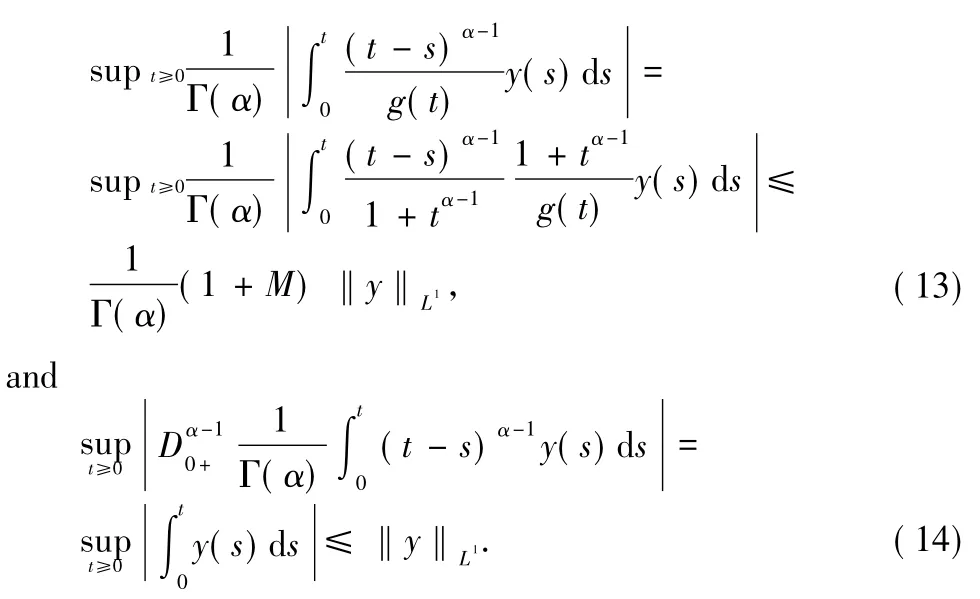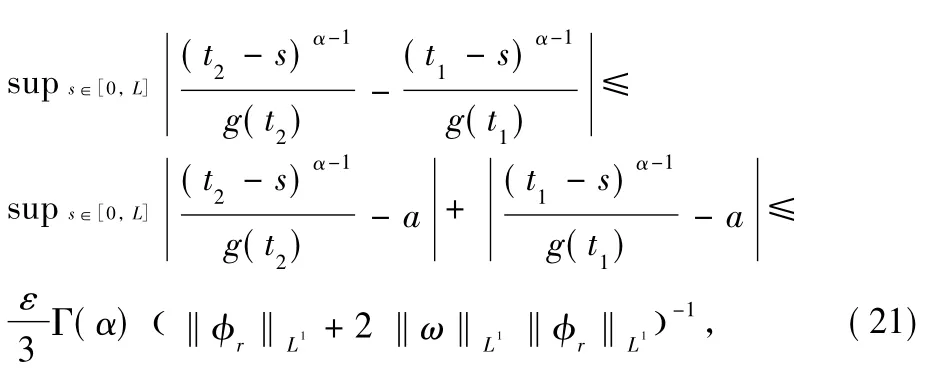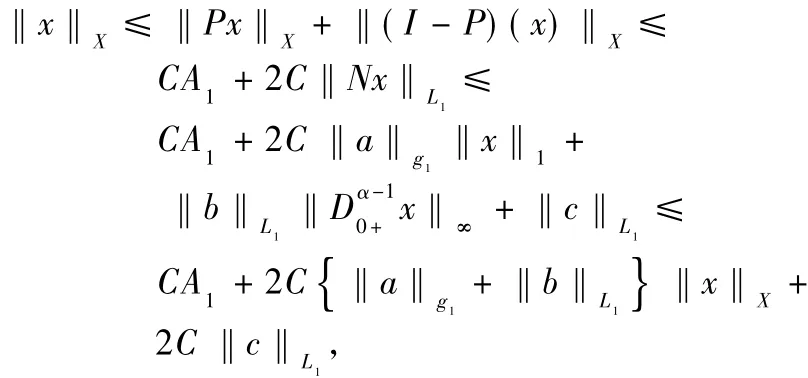Existence of Solutions for Infinity-Point Nonlinear Fractional Boundary Value Problem at Resonance
2015-08-07LIURuijuan刘瑞娟JINRan金冉
LIU Rui-juan(刘瑞娟),JIN Ran(金冉)
1 School of Fundamental Studies,Shanghai University of Engineering Science,Shanghai201620,China
2 College of Information Science and Technology,Donghua University,Shanghai201620,China
Existence of Solutions for Infinity-Point Nonlinear Fractional Boundary Value Problem at Resonance
LIU Rui-juan(刘瑞娟)1,2,JIN Ran(金冉)2
1 School of Fundamental Studies,Shanghai University of Engineering Science,Shanghai201620,China
2 College of Information Science and Technology,Donghua University,Shanghai201620,China
A class of the boundary value problem for fractional order nonlinear differential equation with Riemann-Liouville fractional derivative on the half line was studied.By using the coincidence degree theory due to M awhin and constructing the suitable operators,the existence theorem of at least one solution has been established.An exam ple is given to illustrate our result.
fractional differential equation;infinity-point boundary value problem;coincidence degree theorem;resonance;half line
Introduction
Fractional differential equation can describe many phenomena in various fields of science and engineering such as control,porous media,electrochemistry,viscoelasticity,and electromagnetic.There are a large number of papers dealing with the solvability of nonlinear fractional differentialequations. For details,see Refs.[1-4]and the references therein. References[5-10]considered boundary value problems for fractional differential equations.Recently,various types of multi-point boundary value problems for fractional differential equations at resonance on a bounded domain have been analyzed by Kosmatov[5],Jiang[6],Bai[7],Baiand Zhang[8-9].
However,there are few papers which consider the boundary value problem at resonance for infinity-pointnonlinear fractional equation on a half line.The follow ing fractional differential equation at resonance with multi-point boundary value problem on a half-line was discussed in Ref.[10]:

where1<α≤2,η>0,f:[0,+∞)××→is an SCarathéodory function,andis the standard Riemann- Liouville fractional derivative.
Enlightened by the literatures above,in this paper,we study the existence of solutions for the follow ing fractional differential equations at resonance with infinity-point boundary value problem on an unbounded domain:

where 1<α≤2,0<η1<η2<…<ηi<…,f:[0,+∞)××→is an SCarathéodory function,andis the standard Riemann- Liouville fractional derivative.Moreover,we suppose the follow ing resonance condition:

This condition leads that the fractional differential operatorin Eq.(1)has a nontrivial kernel:

The boundary value problems(1)with such critical condition (2)is so-called problems at resonance.Our main tool is the well-known coincidence degree of Mawhin[11].
1 Prelim inaries
First,Let us briefly recall some notations and an abstract existence result.
Assume Y and Z are Banach spaces,L∈B(Y,Z),then L is called a Fredholm mapping,if the follow ing conditions are satisfied:(1)Im L is a closed subset of Z;(2)dim Ker L<+∞;(3)co dim Im L<+∞.We set the index of L ind L= dim Ker L-co dim Im L,if dim Ker L=co dim Im L<+∞,then L is called a Fredholm mapping of index zero.And if L isa Fredholm mapping of index zero,there exist linear continuous projectors P:Y→Y and Q:Z→Z such that Im P=Ker L,Ker Q=Im L,and Y=Ker L⊕Ker P,Z=Im L⊕Im Q.Then it follows that L|domL∩KerP:dom L∩Ker P→Im L is invertible. We denote the inverse of this map by KP:Im L→dom L∩Ker P.The generalized inverse of thismap is KP,Q:Y→dom L∩Ker P,KP,Q=KP(I-Q).
Assume L:dom L⊂Y→Z is a Fredholm mapping,ifΩis an open bou-nded subset of Y,the map N will be called L-compact onΩif QN:Ω→Z is bounded and KP,QN:Ω→Y is compact.For Im Q is isomorphic to Ker L,there exists an isomorphism JNL:Im Q→Ker L.
Themain toolwe used is Theorem 2.4 of Ref.[11].
Theorem 1[11]Assume-L is a Fredholm mapping of index zero and N is L-compact onΩ,whereΩis an open bounded subset of Y.Suppose the follow ing conditions are satisfied:
(1)Ly≠λNy for each(y,λ)∈[(dom LKer L)∩∂Q]×(0,1);
(2)Ny∉Im L for each y∈Ker L∩∂Q;
(3)deg(JNLQN|KerL,Ω∩Ker L,0)≠0,where Q:Z→Z is a continuous projection as above with Im L=Ker Q and JNL:Im Q→Ker L is any isomorphism.
-Then the equation Ly=Ny hasat leastone solution in dom L∩Ω.
For convenience,we introduce some necessary definitions and resultswhich will be used in the article.
Definition 1[2]The fractional integral of orderα>0 of a function f:(0,∞)→is given by

provided the right side is pointw ise defined on(0,+∞).
Definition 2[2]The fractional derivative of orderα>0 of a function f:(0,+∞)→is given by

where n=[α]+1,provided the right side is pointw ise defined on(0,+∞).
Lemma 1[2]Assume x∈C(0,+∞)∩Lloc(0,+∞).Then

where ci∈R,i=1,2,…,n,n=[α]+1.
In this paper,we use the space X,Y defined by

+→[1,+∞)is a continuous strictly increasing function with g(0)=1,g(t)→+∞as t→+∞.Denote‖x‖1=‖x/g‖∞.By standard argument,we can prove that space (X,‖·‖X)(Y,‖·‖Y)are two Banach spaces.
We suppose the following conditions hold:
(H1)exists.
(H2)f:satisfy the SCarathéodory condition,that is,
(2)for a.e.t∈[0,+∞),(u,v)→f(t,u,v)is continuous on2;
(3)for each r>0,there existsφr(t)∈L1[0,+∞)∩BC[0,+∞)satisfyingφr(t)>0,t∈(0,+∞)such that max{‖u‖,‖v‖}≤r implies

By(H1),there exists constant M>0 such that

Lemma 2[12]Let D be a subset of Banach space(C[0,+∞),‖x‖1).
Then D is relatively compact in(C[0,+∞),‖x‖1),if and only if the follow ing conditions are satisfied:
(1)all functions from D are uniform ly bounded;
(2)all functions from D are equicontinuous on any compact interval of J;
(3)all functions from D are equiconvergent at infinity,that is,for any givenε>0,there exists a T=T(ε)>0 such that it holds

2 Main Results
In this section,we will establish the existence theorem for the sequential fractional differentialequation involving Riemann-Liouville fractional derivative.In order to prove our main results,we need turn the boundary value problem(1)to operator equation.
Define operator L:dom L∩X→Y as follows:

We define N:X→Y be setting N(x(t))=f(t,x(t),
We also define the linear projector operator Q:Y→Y as follows

whereω(t)∈Y satisfiesω(t)>0 andω(s)d s=1.It should be pointed that the definition of Q makes sense since y∈L1(0,+∞)∩BC(0,+∞),then
Lemma 3The operator L:dom(L)⊂X→Y is a Fredholm operator of index zero.The linear operator KP:Im L→dom L∩Ker P→Y can be w ritten as

also

ProofIt is trivial fact thatKer L={ctα-1,c∈R}.Now we show that

Actually,on one hand,let y∈Im L,there exists x∈Dom L such that y(t)=ByLemma 1,=x(t)+From the condition of the boundary value problem(1),we have


and thus On the other hand,suppose y∈Y satisfies Qy=0.Setting x(t)yields

By Qy=0,we know that

It follows from Eqs.(10)and(11)that x∈dom L andThat is to say,Eq.(9)holds.
For y∈Y,taking the projector Q:Y→Y as follows:

Actually,from Q1ω(t)=1,a simple computation shows that Q is a projector.Denote=y-Qy.It is easy to see that

It follows from Eqs.(9)and(12)that∈Im L and thus Y= Im L+Im Q.By y∈Im Q,there exists constant c∈such that y=cω(t),and by y∈Im L,Eq.(9)and Q1ω(t)=1,we obtain

This implies that Im L∩Im Q={0}and Y=Im L⊕Im Q.Thuswe have

which implies that L is a Fredholm operator of index zero.
Taking P:X→X as follows:

then the generalized inverse KP:Im L→dom L∩Ker P can be w ritten by

Actually,for y∈Im L,we have

and for x∈dom L∩Ker P,we know

It follows from x∈dom L∩Ker P,Together with Eq.(2),we get that c1=c2=0 which shows (KpL)x(t)=x(t).Therefore,

This combined with Formula(13)yields Formula(8).This completes the proof.
Lemma 4Let H2hold,then N is L-compact.
ProofObviously,QN and Kp(I-Q)N are continuous. So we only need to prove that QN and Kp(I-Q)N map bounded sets into relatively compact ones.
Suppose U is a bounded subsetof X,then there exists r>0 such that‖x‖X≤r for all x∈U and from(H2),we have

It follows from Formulas(15)and(16)that‖QNx‖Y≤2‖ω‖y‖φr‖L1.Noting that Im Q=2,we get QN is compact.Furthermore,for all x∈U,we have


It follows from Formulas(17)and(18)that KPQNU is uniform ly bounded.Meanwhile,for any fixed T>0,and for any 0≤t1<t2≤T,


Therefore,by Formulas(19)and(20),KP,QNU is equicontinuous.By Lemma 2,we can see that if KP,QNU/g(t)and LKP,QU are equiconvergent at infinity,then KP,QNU is relatively compact in X.In fact,considering the follow ing estimate

holds forε>0 and some L>0,where M is defined in Formula
(5).By(H1),we suppose that=a.Then we have

Thus,there exists T>L such that for t≥T,

Therefore,for t1,t2≥T,we get


So we complete the proof.
Theorem 2 Let the hypothesis(H2)hold and the follow ing conditions are satisfied.
(1)There exist functions a,b,c∈L1[0,+∞),c≠0,such that

(2)There exists constant A1>0 such that for x∈dom L, if for all t≥0,then

(3)There exists constant A2>0 such that for any c∈,either

or else

Then the boundary value problem(1)has at least one solution in space X provided that

ProofWe construct an open bounded setΩ⊂X that satisfies the assumption ofTheorem 1.Let
Ω1={x∈dom LKer L|Lx=λNx,for someλ∈[0,1]}.
For x∈Ω,we have x∈Ker L,λ≠0 and Nx∈Im L,then Ker Q=Im L.Thus Q(Nx)=0.By(2)ofTheorem 2,we know that there exists t∈[0,+∞)such that

It follows from the identityd s thatwe have

Again by x∈Ω,x∉Ker L,then(I-P)(x)∈Dom L∩Ker P and LP(x)=0,thus from Lemma 3,we have

where C=max By Formulas(25)-(26)and hypothesis(H1),we have

which implies that is, Ωis bounded.
LetΩ2={x∈Ker L:Nx∈Im L}.For x∈Ω2,x∈Ker L implies that x=ctα-1,where c is an arbitrary constant. Since QN(x)=0,

where Q is defined in Eq.(6).By the condition(2)ofTheorem 2,we getc≤A2,which impliesΩ2is bounded in X.
Define the isomorphism J:Im Q→Ker L as follows: J(cω(t))=ctα-1,c∈.
If the first part of condition(3)inTheorem 2holds,we set

For any x=ctα-1∈Ω3,one hasλ(cω(t))=λJ-1(x)= (1-λ)QNx.Ifλ=1,then c=0 and,ifc>A2,by the condition(3),it hasλc2ω(t)=(1-λ)ω(t)cQf(t,ctα-1,which contradictsλc2ω(t)>0.If other parts of the condition(3)hold,we take

and again,we obtain a contradiction.Thus,in either case

that is,Ω3is bounded.
SetΩbe an bounded open set such thatΩIt follows fromLemmas 3and 4 that L is a Fredholm operator of index zero and N is L-compactonΩ.By the definition ofΩandTheorem 1,it is sufficient to prove Eq.(3)ofTheorem 1is satisfied.To this end,let H(x,λ)=±λI d x+(1-λ)JQNx,where Id is the identical operator.By virtue of the definition ofthen by the homotopy property of degree,we obtain that

Thus,Eq.(3)of Theorem 1 is fulfilled and Lx=Nx has at least one solution in dom L∩∂Ω..The proof is complete.
3 Exam ple
Consider the boundary value problem

Taking A1=3,for any x∈X,assuming thatholds for t∈[0,+∞),then

The condition(2)ofTheorem 2holds.
It is easy to see that all c>0,we have

We also can prove that if c<0,there is cQf(t,ctα-1,tα-1)>0.The condition(3)ofTheorem 2is satisfied withc>4.So the boundary value problem(1)has at least one solution.
4 Conclusions
In this paper,by using the coincidence degree theory due to Mawhin and constructing the suitable operators,we obtain the existence result for infinity-point boundary value problem at resonance of nonlinear fractional differential equation.An example is presented to illustrate the result.
[1]Hilfer R.Applications of Fractional Calculus in Physics[M]. Singapore:World Scientific,2000.
[2]Kilbas A A,Srivastava H M,Trujillo J J.Theory and Applications of Fractional Differential Equations[M]. Netherlands:Elsevier B.V.,2006.
[3]Lakshmikantham V,Leela S,Vasundhara J.Theory of Fractional Dynam ic Systems[M].Cambridge,UK:Cambridge Academ ic Publishers,2009.
[4]Miller K S,Ross B.An Introduction to the Fractional Calculus and Differential Equations[M].New York:John Wiley,1993.
[5]Kosmatov N.A Boundary Value Problem of Fractional Order at Resonance[J].Electronic Journal of Differential Equations,2010 (135):1-10.
[6]Jiang W H.The Existence of Solutions for Boundary Value Problems of Fractional Differential Equations at Resonance[J]. Nonlinear Analysis,2010,doi:10.1016/j.na.2010.11.005.
[7]Bai Z B.On Solutions of Some Fractional m-point Boundary Value Problems at Resonance[J].Electronic Journal of Qualitative Theory of Differential Equations,2010(37):1-15.
[8]Bai Z B,Zhang Y H.The Existence of Solutions for a Fractional Multi-point Boundary Value Problem[J].Computers and Mathematicswith Applications,2010,60(8):2364-2372.
[9]Zhang Y H,Bai Z B.Existence of Solutions for Nonlinear Fractional Three-Point Boundary Value Problems at Resonance[J].Journal of Computational and Applied Mathematics,2010,doi:10.1007/s12190-010-0411-x.
[10]Zhou H C,Kou CH,Xie F.Existence of Solutions for Fractional Differential Equations with Multi-point Boundary Conditions at Resonance on a Half-Line[J].Electronic Journal of Qualitative Theory of Differential Equations,2011(27):1-16.
[11]Mawhin J.Topological Degree Methods in Nonlinear Boundary Value Problems[C].NSFCBMS Regional Conference Series in Mathematics,American Mathematical Society,Providence,RI,USA,1979.
[12]Agarwal R P,Regan D O.Infinite Interval Problems for Differential,Difference and Integral Equations[M].Dordrecht: Kluwer Academ ic Publishers,2001.
[13]Jiang W H,Huang X Q,Wang B.Boundary Value Problems of Fractional Differential Equations at Resonance[J].Physics Procedia,2012,25:965-972.
[14]Zhang S Q,Hu L,Shi A L.Existence Result for a Nonlinear Fractional Differential Equation with Integral Boundary Conditions at Resonance[J].Advances in Difference Equations,2013,353,doi:10.1186/1687-1847-2013-353.
[15]Chen F L,Zhou Y.Existence Theorem for a Fractional Multipoint Boundary value problem[J].Fixed Point Theory,2014,15 (1):43-58.
[16]Liu R J,Kou C H,Xie X J.Existence Results for a Coupled System of Nonlinear Fractional Boundary Value Problems at Resonance[J].Mathematical Problem in Engineering,2013,doi:10.1155/2013/267386.
[17]Hao X H,Zhou Z F.The Existence of Solutions to a Class of Multi-point Boundary Value Problem of Fractional Differential Equation[J].Journal of Mathematical Research with Applications,2013,33(2):175-188.
O175.8
A
1672-5220(2015)04-0665-07
date:2014-08-18
National Natural Science Foundation of China(No.11271248)
*Correspondence should be addressed to LIU Rui-juan,E-mail:ruirui0516@163.com
杂志排行
Journal of Donghua University(English Edition)的其它文章
- Empirical Analysis of Binary Logistic Model for the Influencing Factors of the Chinese Urban and Rural Residents'Woolen Products Consumption—Based on Questionnaires of 513 Urban and Rural Residents in 16 Provinces
- Analysis of Satisfaction with Business Cost in Shanghai Using Structural Equation Modeling Approach
- Ontology Mapping Based on Bayesian Network
- Diurnal and Seasonal Variations in Particulate Matter at Shanghai during the Heavy Haze and Non-haze Periods
- Swept-Volume Display System Based on Cylindrical Space Projection and Curved Reflectors
- Human Mouth-State Recognition Based on Image Warping and Sparse Representation Combined with Homotopy
